#ajaccio
Îles Sanguinaires, Corse.
I made a painting based on sketches from my trip to Corsica for a friend, so here is my take on these beautiful islands !
Post link
Mirrored from Journey through Napoleonic Europe (blogspot)
The largest and probably best known museum of arts in Corsica takes its name after Napoleon’s maternal uncle, the cardinal Joseph Fesch (1763-1839), whose history with his nephew was turbulent to say the least, but who quite loyally supported the family in general. The museum is located in the palace that used to belong to the cardinal, and its main collection consists of pieces of art, mostly paintings, from the cardinal’s private collection, which is believed to have been the largest private collection of paintings ever, since it used to comprise ca. 16 thousand paintings and some two thousand other objects of art. The cardinal wished in his last will for an institute of arts and sciences to be established in Ajaccio, but due to the contestation of the testament only part of this wish was realized in Corsica. The collection of the museum was later enriched by a number of private donations.
The paintings on display are in the first place Italian paintings from the late medieval to the 18th century, none of them real masterpieces, strong second league, if anything, despite some big names (e.g. Botticelli, Tizian, Veronese’s atelier, Poussin). Religious topics dominate, but for me far more interesting was the collection of natures mortes by the 17th century painter Francesco Noletti, known as Il Maltese, featuring unusual fruits and painstakingly rendered oriental fabrics.

The extended Fesch collection occupies the first and second floors of the museum, and visitors are advised, or even persuaded to begin the visit from the top floor, but the staff does accept the explanation that one would only go to one part of the museum - like I did upon my second visit. (I mention this because there are museums that make one pass through all the rooms despite any kind of protestations.) Anyway, if you do have time, the main collection is worth at least cursory visit, just as the first floor, which gathers mostly later additions to the collection, including several really nice, if again far from exceptional, late 19th century pieces. For those interested in curios related to famous people, and famous military people in particular, or in the reception of ancient history, I recommend looking for the mid-18th century Venetian painting with Alexander at the tomb of Achilles by an artist from the circle of Giovanni Paolo Pannini (first floor, main hall, up on the wall).
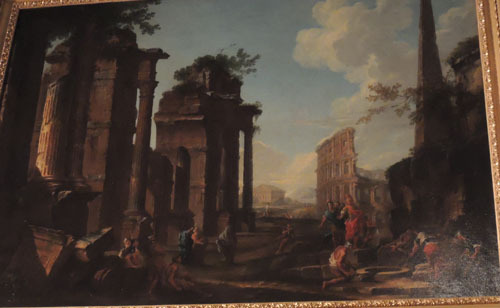
In the basement of the museum there is a nice but hardly breathtaking collection of Corsican paintings, mostly from late 19th century on, including some modern pieces. They show very clearly that second class art was more or less the same everywhere in Europe.
The reader of this blog will, however, probably be most interested in the three rooms on the ground floor that host the Collection Napoléonienne. The first room offers a really rich array of sculpted portraits (Fesch by Antonio Canova, most by less known sculptors) of assorted members of the family; the larger than life full statue of Jérôme in the ceremonial robes of the king of Westphalia dominates the scene, while other people are represented by Roman style busts. The “Roman style”, by the way, does not apply just to the type of sculpted portrait developed in ancient Rome (the bust) but also to details of dress and especially ornaments worn by several of the portrayed. Actually some of the elements have ancient Greek provenance (for instance the characteristic headdresses of the women imitate the Greek stephane worn by goddesses and Hellenistic queens), but were adopted in the official Roman portraiture, and later imitated in the Neo-Classical style of the 1st Empire.
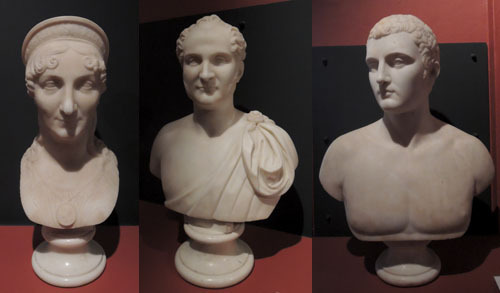
The second room boasts one of the famous portraits of Napoleon in the coronation (the Sacre) robes, painted by François Pascal Simon, baron Gérard (usually referred to simply as Gérard). In accordance with the style and fashion every detail is very thoroughly rendered, and the portrait is supposed to emanate majesty and power. Even if he was one of the most gifted painters of his age, Gérard did not have the talent of Jacques-Louis David, but still I personally believe that this is the best of non-David official portraits related to the coronation. I will devote a separate note to the details of this painting one day.

There is also a number of other portraits in this room and the next one (e.g. Carlo, Joseph, Lucien, the little Roi de Rome, Félix Baciocchi, Alexandrine de Bleschamp, Cardinal Fesch, Napoleon III, and some others), out of which my favourites are two Gérards that I would count among his best works: Caroline and the iconic Madame Mère, as well as the little Marie-Laetitia Murat carrying the bust of her uncle (author: Jeanne-Elisabeth Chaudet-Husson). As for the latter, I really love the way the paintress captured the smug expression on face of the little girl and I was mesmerized by the display of period children’s toys on the left (I remember my parents teaching me to make that origami-like paper horse when I was a child!).

Two relatively small paintings portraying Lucien Bonaparte and his first wife Christine Boyer, is certainly worth the visitor’s attention: at closer inspection it becomes clear that they show the same scene from two different perspectives (actually the second is included in the first, or the other way round: the second is part of the first, only zoomed-out):
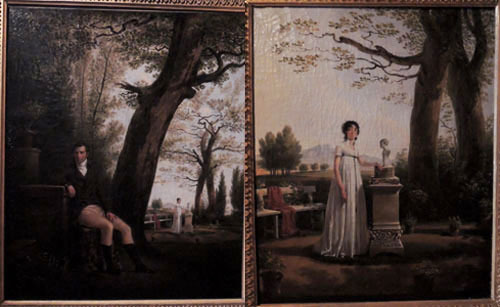
Several paintings more loosely related to the historical events, and the rest of the two rooms is dedicated to a variety of memorabilia, among which is the indispensable death mask (I counted 8 of these in Corsica alone, will be possibly returning to their typology on the occasion of Maison Bonaparte) and possibly the single most morbid curio I have seen, at least so far: a miniature coffin, together with its miniature content. Otherwise the display cases contain mostly the typical stuff: figurines (including the always moving apotheosis of the Duke of Reichstadt and a nice Napoleon on a camel), miniature portraits and cameos.
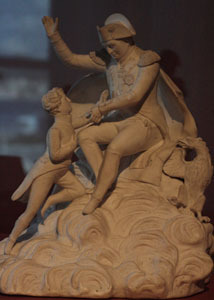
The arrangement of the items may seem a bit exotic at times: for instance the display cases in the second room contain the church paraphernalia that used to belong to cardinal Fesch accompanied by a box with a pornographic image of Marie-Louise and general Neipperg. Chronological arrangement does not work, either, since the third room hosts both posthumous memorabilia on Napoleon and the Roi de Rome, and very much lifetime objects of everyday use (e.g. a field nécéssaire that used to belong to Jérôme as the king of Westphalia). All in all it is in the period fashion, since it recalls the atmosphere of the cabinets of curiosities.
The museum usually hosts temporary exhibitions, and has a good shop with numerous exhibition catalogues, books, clothes and good taste souvenirs. The large courtyard with the statue of the cardinal makes a good spot for a short rest.
To the right from the museum entrance is the Chapelle Impériale, which was built in the time of the 2nd Empire, and where a number of the Bonaparte family members are now buried, but it was closed for renovation in 2013 and no information was given as to when it is due to be open for visitors again.

Practical information
Address:
Musée des Beaux-Arts d’Ajaccio, Palais Fesch
50-52 rue cardinal Fesch, Ajaccio
GPS data: N 41.91311 E 008.72454
Opening hours:
May 2 - Sept 30
Mon, Wed, Sat 10:30 a.m - 6:00 p.m.
Thu, Sun 12:00 a.m - 6:00 p.m.
Fri 12:00 a.m - 6:00 p.m. (July and Aug 12:00 a.m - 8:30 p.m.)
Oct. 1 - Apr. 30
Mon, Wed, Sat 10:00 a.m. - 5:00 p.m.
Thu, Fri 12:00 a.m. - 5:00 p.m.
Third Sun of every month 12:00 p.m - 5:00 p.m.
Closed on Tuesdays, and on Christmas; New Year; Nov 1 and 11; Mar 18; Easter; May 1.
Admission: full EUR 8; reduced EUR 5.
Tickets are valid all day, so one can go in and out at will.
Photography is allowed.
Personal belongings may be left in the cloakroom for free.
I was pondering where to start, and after some time I realized that the only place I can start is Ajaccio. And since at some point I decided that major sites should receive both overview articles and then detailed descriptions of particular places of interest in separate notes, therefore here it is: a general thematic stroll through Ajaccio.
As the birthplace of Napoleon Bonaparte and vast majority of his siblings (with the exception of the eldest, Joseph, who was born in Corte), Ajaccio celebrates its most famous citizen by a series of museums and monuments as well as by yearly festivals (fireworks, parades, but also lectures etc.; I missed it this year but hope to be there next year) around August 15th. The city is generally overflowed with the Bonapartes, and the sign at the main entrance (from the east, i.e. from all major roads) informs us that we are in the Imperial City (similar decorations include the imperial crown in Avenue du Premier Consul/Cours Napoléon and the Legion d'Honneur in Cours Grandval).
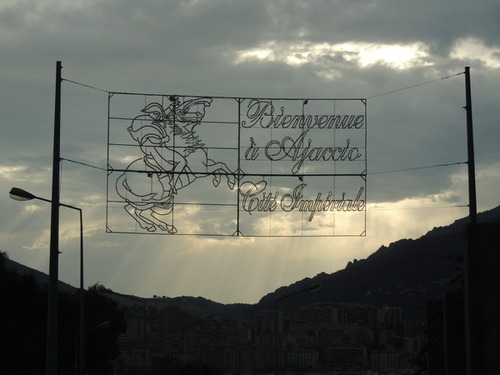
Must-see places include three museums: the Maison Bonaparte (rue Saint-Charles 1), the two rooms in the Musée Fesch (rue Cardinal Fesch 50-52), and the Salon Napoléonien in the city Townhall (Hôtel de Ville; Place Foch), and three monuments: Napoleon as First Consul in Place Foch, Napoleon on the horseback in the company of his four brothers (Place de Gaulle) and the Casone in Place d'Austerlitz, together with the Grotte Napoléon.
Additional traits in the city centre include the period room in the small museum A Bandera (Corsican history), the cathedral of Notre Dame (rue Forcioli Conti) where Napoleon was baptised, the church of Saint Jean Baptiste (rue Roi de Rome/rue Saint-Charles) where other members of the family were baptised, and the building at rue Fesch 28, where a board inform us of the short stay of Napoleon during his escape from Corsica in May 1793.
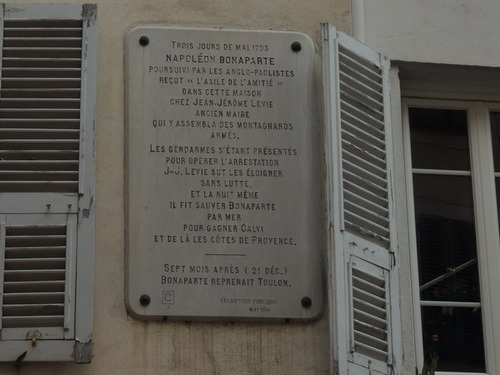
Hardcore fans may also try to collect the whole range of street signs related to both the 1st and 2nd Empire (battlefields are concentrated in the residential area in the western part of the city, close to Place d'Austerlitz, other streets, boulevards, avenues etc. are situated in various parts of the city; note that some people appear twice, for instance there is rue Letizia and boulevard Madame Mère, so don’t strike someone out just because you spotted them once).
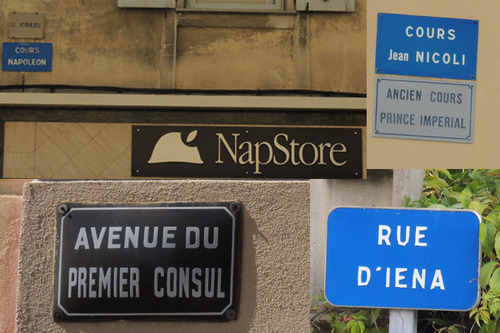
Names of numerous bars, restaurants, cafes and ice-cream lounges also relate to the characters of the period, while some of them make other use of the city’s main attraction (food at affordable prices is really good here, so it can be recommended):
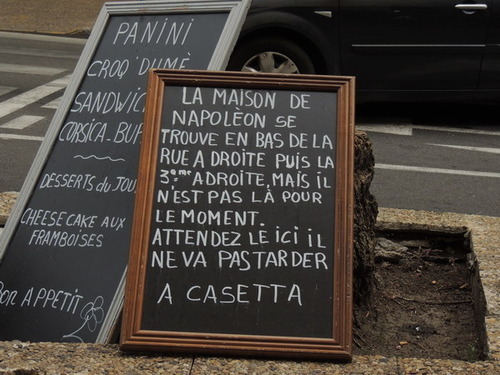
For the atmosphere and numerous prints on the walls, as well for good quality food, the Grand Cafe Napoléon is a culinary must: the pictures cover most of the period’s history, and the large dining room is predictably decorated with the copy of the famous Passage of St. Bernard by David.
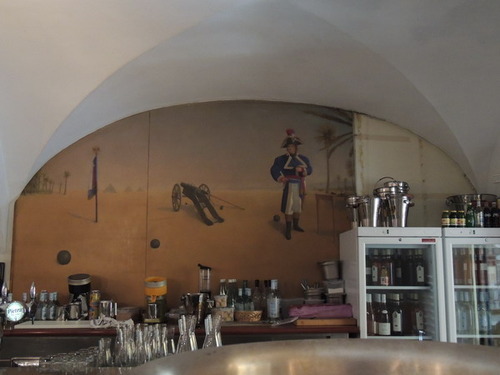
Away from the centre is Les Milleli - the favourite house of Napoleon during his military service in Corsica. Also the Napoléon Bonaparte airport is some way from the city centre to the east, on the seaside. Signs leading to it abound in the city and on its outskirts. Outside Ajaccio, on the way towards the Îles Sanguinaires, on the left hand side of the road westward, are curious remains of either a demolished or an unfinished structure, among which one features undoubtedly the well known silhouette:
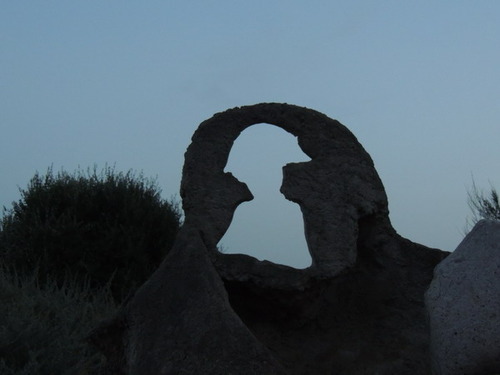
The shops, of course, team with souvenirs, but most of them are kitsch and cheap; however, two boutiques for better value objects are located close to the Maison Bonaparte (Boutique Napoléon just a few steps away from the entrance to the museum; Empires in rue Roi de Rome - the latter’s commodities can also be purchased in museum shops and in the Office de Tourisme d'Ajaccio shop, Boulevard Roi Jérôme 3).
The library in Place Foch has a large selection of books on Corsican history and Napoleonic period on the ground floor.
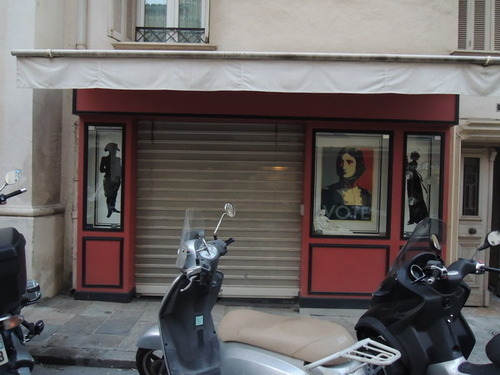
Places related to the period include the birthplace of Carlo Andrea, count of Pozzo di Borgo, once friend and later oponent of Napoleon in the matters of Corsican independence (rue Bonaparte; now converted to the Palazzu u Domu hotel), and several monuments/boards commemorating Pasquale Paoli (e.g. the monument in Bd. Danielle Casanova, by the walls of the Citadel).
Other places of interest include the Genovese trail, of which the Citadel is part (look out for donkeys and goats climbing the walls in the now dry moat), and the Quartier des Étrangers, which is partly connected with the development of the city under the II Empire.
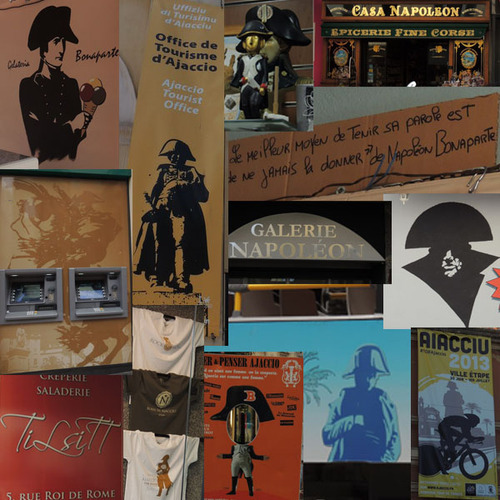
PRACTICAL INFORMATION
Ajaccio, which is the capital of the A1 department (Corse-de-Sud) and hosts the prefecture for the whole island, is situated in central Corsica, in a large bay on the western coast. It has its own airport and ferry port, and can also be easily reached from the main port and second airport in Bastia (ca. 150 km on the direct N 193, below 3 hours of comfortable drive, unless you stop every several miles for breathtaking views and charming little villages).
It is a seaside city with fine climate: the summer heat is balanced by the sea breeze most of the time. The city offers wonderful beach with stunning views. It preserves the atmosphere of the previous turn of centuries in many respects, and (fortunately) is nothing like the modern beach towns of continental Europe.
The historical centre and most of the attractions listed here can be easily reached on foot from most of the in-town hotels, but there are also buses running from the major nearby attractions, where many hotels are located. It is not advisable to try to find parking space in the centre: it is hard to find and expensive, while leaving your car outside the payment zone means that you have to walk some 5-10 minutes through seaside boulevards. To reach Les Milleli it is better to have a car, although seasoned walkers should not have any problems in getting there (no public transportation, though).
Most restaurants close between 2 and 3 p.m. for a long break until 7 p.m., so it is only possible to eat something substantial in selected cafes and fast foods in that time. Most museums also have breaks during the day (and unpredictable free days, too), so it is better to check opening times while planning the visit.

Paysanne des environs d'Ajaccio (Corse), vers 1910
Photo:Jacques Boyer


